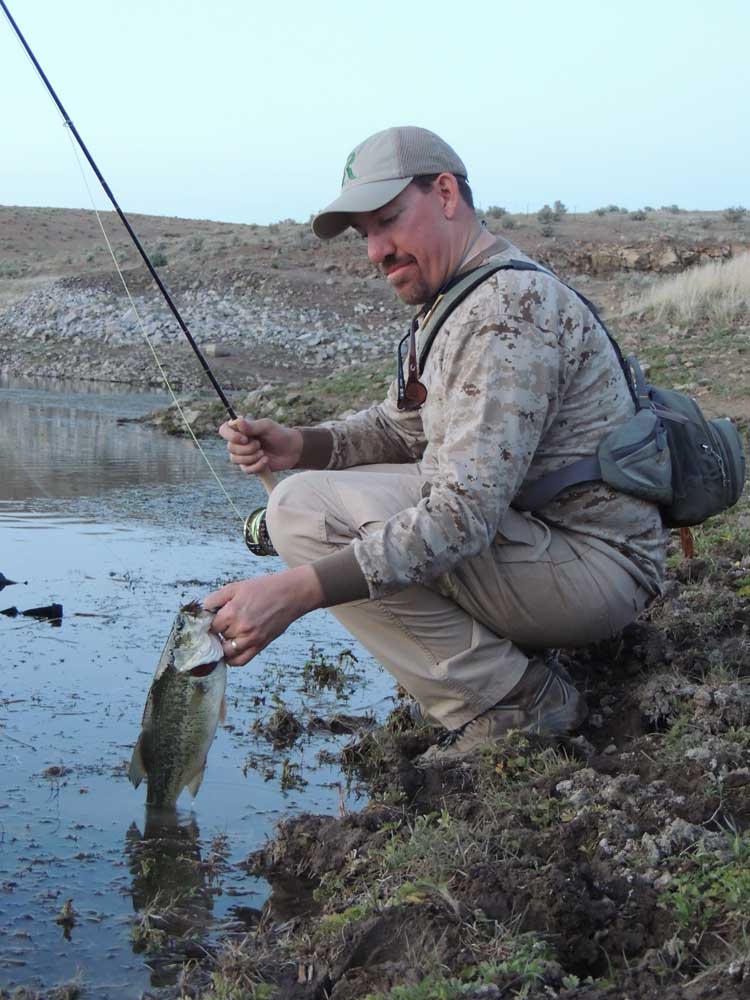Fly rod bugs for largemouth bass
Published 12:00 am Wednesday, May 6, 2015

- Gary Lewis / For The BulletinJesse Riding, of Logan, Utah, lifts out a largemouth that ate a swimming frog pattern.
Each April, we shoot vermin to protect alfalfa and keep the agriculture organic. Steve McGrath, from Camp Chef, and Jesse Riding, from Rainy’s Flies, drive west from Utah, and I drive east, and we meet in Crane, where the sage rats are hard at work to wipe out farmers’ crops.
We hunted again with Nikki and Justin Aamodt’s Diamond A Guides and Seth “Rat Squeaker” Franklin, a 29-year-old guide who speaks the language. To coax a rat from its hole, Franklin chirps to mimic the motherless juvenile. He smooches the mating sounds and calls up the big females with the mews of a deadbeat dad skipping out with the child support check.
Dan and Debbie Goetz, of Warne Scope Mounts, were along for Debbie’s first hunt of her life. She did not shrink from the work. By her count, she fired more than 500 rounds. We took a break at noon, and Riding grabbed clippers and went out and harvested tails to tie streamers. McGrath whipped out the single-burner stove with a grill box, and after a few minutes he served up chicken cordon bleu sandwiches.
We might have shot till dusk, but Riding had brought fly rods and a box full of bass flies.
Franklin pointed the way deep into those hills north of the Steens, and we found ourselves on his aunt and uncle’s doorstep. The water was low, they told us, and they had just driven their cattle down, and the creek was muddy. They didn’t inspire a lot of confidence in our prospects.
We stopped the truck on a high spot and looked down on the water, which was quite a bit lower than it would have been in a normal year.
We spotted a weed patch close to the dam. I tied on a Warpath’s Olive Whammy Craw on a short leader. I cast and stripped it hard, but the bass didn’t want to eat it that way. One charged in, missed and streaked away.
On the other side of the weed patch, I pitched the big olive streamer 5 feet from the rock I was standing on. A fish appeared, swung a semicircle, opened a wide bucket mouth and expelled water through its gills, and the fly vanished inside. I set the hook as if it was stuck in a log.
Stung, in disbelief, the fish tried to get back into the weeds, then it streaked out to open water and danced on its tail.
I don’t know how much it weighed, as I was more concerned with getting it back in the water, but it could have been the biggest largemouth I’ve caught on a fly. Maybe I should have eaten it, but I like to think there will be enough water that the big fish will make it through the summer.
Fly-fishing for largemouth and fly-fishing for trout do not have a lot in common. Bass are reaction biters, and the bigger the bug, the better. Keep in mind, a largemouth will eat a duckling. Once, I watched a bass consume a bird it plucked off a rock. It took a few minutes for the wingtips and legs to disappear inside its mouth.
A bass angler who wants to tie into a largemouth with streamer or popper doesn’t have to know a lot to start. And a bass fisherman doesn’t have to be a pretty caster. There is nothing graceful about a bass fly.
In Skip Morris’ new “Survival Guide for Beginning Fly Anglers,” he breaks underwater flies into two categories: small fish imitations — such as the Zonker or Clouser Minnow — and general use with a heavy bead or cone — such as Whitlock’s Scorpion or Skip’s Brown Trout Minnow.
Floating flies are divided into two types. The first are the hair bass bugs with a brown, yellow, tan or green body (not including the tail) about five-eighths of an inch long. Morris likes a white or yellow face on these bugs. Diving flies include the Dahlberg Diver and Umpqua Swimming Frog. Diving bugs have a head or body that tapers from narrow in front to broad at the rear. Sometimes a diver is the bug the bass want.
When the rest of us were finished, Riding wanted to fish five more minutes. Clever. He didn’t say five more casts. We watched as his five minutes turned into 25 minutes, the wind died down, and the water turned to glass.
Riding worked his way along the shore with a Schiel’s Deep Swimming Frog that swam like an amphibian with kicking legs. He stripped it slow, rhythmically, with long pauses. Bass watched it swim by, maybe once, maybe twice, then they attacked it.
East of the Cascades, if fly-rod largemouth are on the menu, Davis Lake, Krumbo Reservoir and Prineville Reservoir are good options. Close to Bend, the Pine Nursery Pond can produce some big fish. Bass fishing is hot a lot earlier this year, and the fish are on the prowl.
— Gary Lewis is the host of “Frontier Unlimited TV” and author of “John Nosler – Going Ballistic,” “A Bear Hunter’s Guide to the Universe,” “Hunting Oregon” and other titles. Contact Lewis at www.GaryLewisOutdoors.com.






